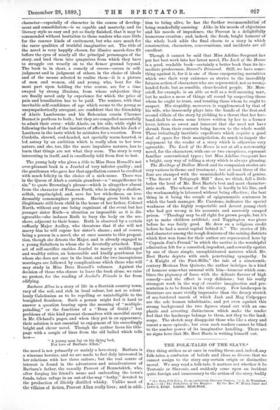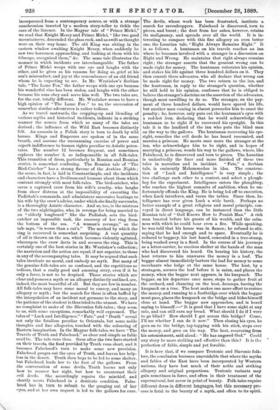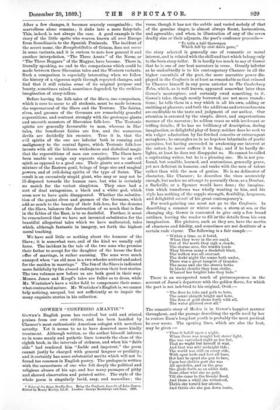THE FOLK-TALES OF THE SLAVS.*
ONE thing strikes us at once in reading these, and, indeed, any folk-tales, a confusion of beliefs and ideas so diverse that we cannot assign to the story any certain origin or distinctive moral. We may read a folk-tale, it matters not whether it be Teutonic or Slavonic, and suddenly come upon an incident quite foreign and unnecessary to the action of the story, bodily • (1.) Sixty Folk-Tales. From exclusively Slavonic Sources. ry A. H. Wratislaw, M.A.—(2.1 The Folk-Tales of the Magyars. By the Rev. W. Henry Jones and
Lewis L. Erepf. London: Elliot Stock. incorporated from a contemporary source, or with a strange anachronism inserted by a modern story-teller to tickle the ears of the listener. In the Magyar tale of " Prince Mirk6," we read that Knight Mezey and Prince Mirk6, " like two good mountaineers, descended the glass rock, and as swift as thought were on their way home. The old King was sitting in the eastern window awaiting Knight Mezey, when suddenly he saw two horsemen approaching, and looking at them with his
telescope, recognised them," &c. The same tale illustrates the
manner in which incidents are interchangeable. The father of Prince Mirk6 weeps with one eye and laughs with the ether, and he gives as his reasons for doing so, grief at his son's misconduct, and joy at the remembrance of an old friend whom he is expecting to see. In Mr. Wratislaw's Serbian tale, "The Lame Fox," the father weeps with one eye because his wonderful vine has been stolen, and laughs with the other because his sons obey and serve him well. The two tales are, for the rest, totally different. Mr. Wratislaw seems to have a *high opinion of " The Lame Fox :" to us, the succession of somewhat similar adventures is rather tedious.
As we travel eastwards, the cropping-up and blending of various myths and historical incidents, indicate in a striking
manner the source from which so many of the tales are -derived ; the influence of the Wild East becomes distinctly felt. An assassin in a Polish story is torn to death by wild horses. Kings and Emperors are spoken of in the same breath, and assume the unreasoning exercise of power and superb indifference to human rights peculiar to Asiatic poten- tates. The number 12 becomes frequent, and sometimes replaces the number 3, so indispensable in all folk-tales. This transition of dress, particularly in Russian and Bosnian stories, is somewhat confusing. The Bosnian tale of " The Bird-Catcher" has a strong flavour of the Arabian Nights ; the scene, in fact, is laid in Constantinople, and the incidents and characters have a liveliness and humour about them which contrast strongly with most folk-tales. The bird-catcher, who saves a captured crow from his wife's cruelty, who laughs from sheer distress at the impossibility of executing the Padishah's commands, and administers successive beatings to his wife by the crow's advice, under which she finally succumbs, is a thoroughly Asiatic character. And so, too, is the mistress of the two nightingales, who, in revenge for being married to an " elderly longbeard " like the Padishah, sets the bird- catcher an impossible task, the recovery of her ring from the bottom of the sea. " A woman's revenge," so the tale says, "is worse than a cat's." The method by which the ring is recovered is somewhat surprising. A vast quantity of oil is thrown on the sea, which becomes violently agitated, whereupon the crow darts in and secures the ring. This is certainly one of the best stories in Mr. Wratislaw's collection ; the narration and the action are equal, if not superior, to those in any of the accompanying tales. It may be argued that such tales inculcate no moral, and embody no myth. But many of the genuine folk-tales are so confused, and the repetitions so tedious, that a really good and amusing story, even if it be only a farce, is not to be despised. Those stories which are clear and possess a myth or an allegory distinctly outlined, are, indeed, the most beautiful of all. But they are few in number. All folk-tales may have some moral to convey, and many an allegory or myth ; but the search for these is often baffled by the interpolation of an incident not germane to the story, and the patience of the student is thus tried to the utmost. We have no complaint to make of the Slavonian folk-tales ; they seem to us, with some exceptions, remarkably well expressed. The tales of " Luck and Intelligence," " Fate," and " Death " reveal not only the fatalism peculiar to Orientals, but some noble thoughts and fine allegories, touched with the colouring of Eastern imagination. In the Magyar folk-tales, we have " The Travels of Truth and Falsehood," as clear and simple as fable need be. The tale runs thus. Soon after the two have started on their travels, the food provided by Truth runs short, and it becomes Falsehood's turn to make some new provision. Falsehood gouges out the eyes of Truth, and leaves her help- less in the desert. Truth then begs to be led to some shelter, but Falsehood leads her to the foot of the gallows. From the conversation of some devils, Truth learns not only how to recover her sight, but how to counteract their evil deeds. She accordingly repairs the mischief, and shortly meets Falsehood in a destitute condition. False- hood has in turn to submit to the gouging out of her eyes, and at her own request is led to the gallows for cure.
The devils, whose work has been frustrated, institute a search for eavesdroppers. Falsehood is discovered, torn to pieces, and burnt ; the dust from her ashes, however, retains its malignancy, and spreads over all the world. It is in- teresting to compare with this fine allegory an even better one, the Lusatian tale, "Right Always Remains Right." It is as follows. A huntsman on his travels reaches an inn where he becomes involved with a stranger in a discussion on Right and Wrong. He maintains that right always remains right ; the stranger asserts that the greatest wrong can be made right for money. The huntsman reiterates his opinion, and stakes his life against three hundred dollars on it. They then consult three advocates, who all declare that wrong can be made right for money. The two return to the inn, and the huntsman, in reply to the stranger's question, whether he still held to his opinion, confesses that he is obliged to believe the stranger's doctrine on the assertion of the advocates, though most unwilling to do so. The stranger, on the pay- ment of three hundred dollars, would have spared his life, but another man coming in almost persuades him to exact the penalty ; he, however, only puts out the huntsman's eyes with a red-hot iron, declaring that he would acknowledge the huntsman to be right if he recovered his eyesight. In this tale it is the landlord of the inn who puts the blind man on the way to the gallows. The huntsman recovering his eye- sight, remedies the evil deeds he has heard recounted, and marries a princess. He meets once more the stranger at the inn, who acknowledges him to be right, and in hopes of marrying a princess, wends his way to the gallows, where, like Falsehood, he is discovered and torn to pieces. The Lusatian is undoubtedly the finer and more finished of these two tales in narration and in incident. " Fate," a Serbian tale, is eminently Mahommedan in idea. The construc- tion of " Luck and Intelligence" is very simple ; the two challenge each other to a contest, and select a plough- boy for the experiment. Intelligence enters the ploughboy, who reaches the highest summits of ambition, when he un- fortunately offends the King. He is being led off to execution, when Luck interferes, and turns the tables. Since then, In- telligence has ever given Luck a wide berth. Perhaps no better example of a great religious and moral principle, con- veyed in direct language, can be instanced than the little Russian tale of " God Knows How to Punish Man." A rich man boasted before his guests of his wealth, and the calm- ness with which he could bear even a fire. While speaking, he was told that his house was in flames ; he refused to stir, saying that he had enough and to spare. Eventually he is reduced to beggary, his last hoard, concealed in a tree-stump, being washed away in a flood. In the course of his journeys as a letter-carrier, he receives shelter at the hands of the man who had discovered his hoard. On hearing his history, the host returns to him unawares the money in a loaf. The beggar almost immediately barters the loaf for money to some merchants who lodge at the same house. The host, by a stratagem, secures the loaf before it is eaten, and places the money, when the beggar next appears, in his knapsack. The beggar, on his departure once more, stops to gather fruit at the orchard, and chancing on the host, decamps, leaving the knapsack on a tree. The host makes one more effort to restore the money, and running to a footbridge over which the beggar must pass, places the knapsack on the bridge and hides himself close at hand. The beggar now approaches, and is heard saying to himself :—" It is good that I have some sight at any rate, and can still earn my bread. What should I do if I were to go blind P How should I get across this bridge P Come, I'll see whether I can do it now." Then closing his eyes, he goes on to the bridge, tap-tapping with his stick, steps over the money, and goes on his way. The host, recovering from his astonishment, said aloud : " He has angered God." Could any story be more striking and effective than this ? It is the perfection of fable, simple and yet forcible.
It is here that, if we compare Teutonic and Slavonic folk- lore, the conclusion becomes unavoidable that where the myths and fables of the East have been incorporated by Western nations, they have lost much of their noble and striking allegory and original proportions. Teutonic variants may gain sometimes in force, and often in their treatment of the supernatural, but never in point of beauty. Folk-tales require different dress in different languages, but this necessary pro- cess is fatal to the beauty of a myth, and often to its spirit.
After a few changes, it becomes scarcely recognisable ; the marvellous alone remains ; it sinks into a mere fairy-tale. This, indeed, is not always the case. A good example is the story of the little sprite who weaves, known all over Europe from Scandinavia to the Spanish Peninsula. The incident of the secret name, the Rumplestiltskin of Grimm, does not occur in some variants, and it is curious to note how general it and another interpolation, "The Three Aunts" of the Norse, or "The Three Beggars" of the Magyar, have become. There is, ' literally speaking, no end to the comparisons which could be made between these Slavonian tales and the Western variants. Such a comparison is especially interesting when we follow the history of a vigorous myth through repeated changes, and find that it still retains some of its original purpose and beauty, sometimes raised, sometimes degraded, by the reckless imagination of story-tellers.
Before leaving the folk-tales of the Slays, one comparison, which is sure to occur to all students, must be made between the supernatural of the Slays and the Teutons. The fairies, elves, and gnomes of the Germans are remarkably graceful superstitions, and contrast strongly with the grotesque giants and uncouth monsters of Slavonian folk-lore. The Teutonic spirits are generally favourable to man, whereas in Slav tales, the beneficent fairies are few, and the numerous devils are decidedly his enemies. True it is, that the evil spirits of the one are inferior both in cunning and malignancy to the central figure, which Teutonic folk-lore invests with all the hideous wickedness and diabolical magic that the superstitions of man can conceive. The Slays have been unable to assign any separate significance to an evil spirit as opposed to a good one. Their giants are a confused mixture of the Eastern genii, beings of huge size and magical powers, and of evil-doing spirits of the type of Satan. The result is an excessively stupid giant, who may or may not be ill-disposed towards the human race, but who is certainly no match for the veriest simpleton. They once had a sort of dual antagonism, a black and a white god, which seem, now to have quite disappeared. Whether the substitu- tion of the quaint elves and gnomes of the Germans, which add so much to the beauty of their folk-lore, for the demons of the Slays, balances the destruction of so much that is fine • in the fables of the East, is to us doubtful. Farther, it must be remembered that we have not invented substitutes for the beautiful allegorical tales which we have maltreated, tales which, although fantastic in imagery, set forth the highest moral teaching.
We have said little or nothing about the humour of the Slays ; it is somewhat rare, and of the kind we usually call farce. The incident in the tale of the two sons who promise their father to accept for the daughter of the house the first offer of marriage, is rather amusing. The sons were much annoyed when " an old man in a two-wheeler arrived and asked for the maiden in marriage." The fun of the Slays is indicated more faithfully by the absurd endings to even their best stories. The two volumes now before us are both good in their way. Messrs. Jones and Kropf's tales are fuller as to dress, while Mr. Wratislaw's have a wider field to compensate their some- -what contracted nature. Mr. Wratislaw's English is, we cannot help noticing, unequal, but not sufficiently so to impair the many exquisite stories in his collection.




































 Previous page
Previous page